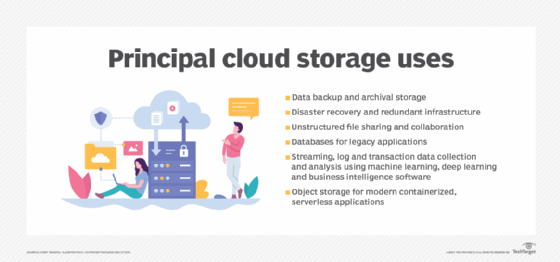
Getty Images/iStockphoto
7 best practices for cloud storage migration
While some organizations are moving data back on site, cloud storage is still popular. A successful migration is important -- these best practices and third-party tools could help.
The demand for cloud storage remains strong as companies benefit from its cost and scalability. As a result, cloud storage migration is a frequent activity for IT teams.
Despite its popularity, cloud storage migration is complex and potentially risky. Admins must manage technical hurdles, mitigate data loss risks and maintain business continuity. Companies should follow cloud storage migration best practices to ensure a successful transition. This way, they'll maximize the benefits of the migration, overcome any challenges, and create a more efficient and cost-effective cloud storage environment.
Cloud storage migration best practices
A strong cloud storage migration plan should include the following best practices.
1. Understand the new location's tech specifications
Since each cloud storage platform has different rules and specifications, you'll need to know what file types are allowed, file and folder name character limits or restrictions, and file path length character limits. Each of these could cause an organization to leave data behind or corrupted through no fault of the transfer.
2. Evaluate the network connectivity
Consider the network connectivity options, including bandwidth and latency. Verify the data centers, IP addresses and regions where the organization currently stores the data and where it will access the data after the move. Verify if the new platform provides direct connections and VPNs to ensure secure connectivity as needed.
3. Confirm security and compliance
Data security is especially important if you move proprietary data or are in a highly regulated industry like financial services or health care. Confirm that the new cloud storage provider offers relevant security options, such as encryption, threat detection and prevention, and compliance with industry standards like SOC 2 and ISO 27001.
4. Ensure minimal user impact
Avoid downtime or other issues when you cut over to the new storage platform. You need a high migration fidelity where files and folders move without alteration to names, permissions, metadata and file attributes.
5. Define the migration scope and timeline
Data storage access varies, so create a priority list. The list should define the order in which data stores move and consider factors such as business impact, complexity and any dependencies. A phased approach that starts with less critical or standalone storage might work best.
6. Communicate early and often
Keep team members, stakeholders and other affected users aware of the migration plan. Communicate the timeline and dependencies as needed so they can prepare for potential downtime or changes to their workflows while you migrate.
7. Complete all post-migration activities
A successful cloud storage migration doesn't end once the final pieces arrive at their new storage location. Monitor the new location to ensure everything works. Verify items like time-to-live values, bandwidth levels and connection strings. Deactivate the old storage location and verify the end of the subscription if necessary.

Benefits and challenges
Cloud storage vendors regularly adjust their pricing models and storage quotas so customers can lower their costs. For example, move stale or obsolete data to archival cloud storage to save money. Different platforms might offer improved security and performance with the latest high-speed computing resources and technologies.
That said, cloud storage migration risks may block or prevent a smooth transition. Risks include technical blockers, regulatory constraints, performance availability and interconnectivity between migrated and non-migrated workloads. For example, a high-availability service-level agreement might challenge a geographically widespread user base if the destination cloud storage platform is in a location with poor connectivity.
Top tools
Most of the top tools for cloud storage migration function similarly. They enable users to move data from cloud to cloud, from on premises to cloud, and between vendor cloud storage buckets. They generally enable users to move object and file storage, distributed file systems, containerized data, data warehouses and data lakes.
Here are migration tools from three cloud storage hyperscalers with pricing from the vendors as of January 2024.
- AWS DataSync: Pricing depends on how much data you're moving but is generally a flat per-gigabyte fee depending on your AWS region.
- Azure Migrate: Pricing is free with an Azure subscription. If using Azure tools alone, admins face additional fees for third-party partner tools.
- Google Cloud Storage Transfer Service: Pricing is 1.25 cents per gigabyte to transfer using agents with Google Cloud Storage Transfer and free with all other sources.
Editor's note: The unranked list is based on web research and presented in alphabetical order.
Julia Borgini is a freelance technical copywriter and content marketing strategist who helps B2B technology companies publish valuable content.








